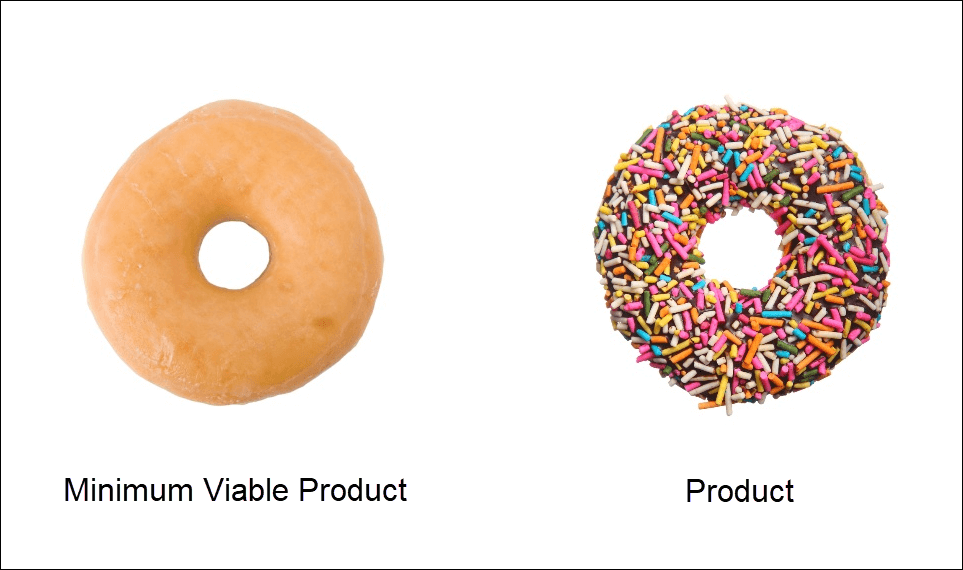Reading Time: 9 minutesThere are currently 3.5 billion smartphone users worldwide, and they have between 60 and 90 apps installed on their devices. For mobile app developers or anyone else interested in creating an app, this translates into a $150 billion opportunity.
To take advantage of this opportunity, it’s no longer enough to simply make an app and publish it on a digital distribution platform such as Apple’s App Store or Google’s Play Store. These days, the competition for mobile users’ attention is so fierce that app developers have to carefully plan each and every step in order to stand out.
Regardless of if this is your first time embarking on an app development journey or if you have some experience with building mobile applications and want to learn something new, this article will teach you how to create a successful mobile app that users will keep coming back to over and over again.
1. Conceptualize Your App Idea

Not all app ideas are equally great and worth turning into functional apps. Before you start building your app, you need to verify that it doesn’t sound good only in your head. It’s always a good idea to start with a bit of background research to learn more about your audience. Here are some places where you can validate whether your target audience will be receptive to your app:
- Social media networks: Many app developers are reluctant to share their app ideas on social media because they worry that someone might steal them. In most cases, such fears are completely unfounded, and they stop developers from collecting extremely valuable early feedback.
- Meetups and hackathons: When you surround yourself with like-minded app developers who are trying to build mobile applications with the potential to top the charts, you become energized and inspired to make your app idea even better. Meetups and hackathons are organized almost everywhere these days, so you just need to find one close to you and sign up.
- Digital distribution platforms: Is there already a similar app published on one of the main digital distribution platforms? If there is, how closely it matches your idea? What do users like and dislike about it? When you seek answers to these and other questions, your rough app idea will start getting a more concrete shape.
After a bit of research, you should be able to summarize your app idea with just one or two sentences:
- A navigation app with offline digital maps of all local shopping malls.
- An app that encourages you to take a selfie every day. It then turns the selfies into a movie.
- Tinder but for finding people to do a specific activity with.
A short description like this makes it clear what the main features of the app are, and you can either keep refining them on paper or, better yet, build a simple prototype to have a functional app as soon as possible.
2. Create a Development Plan

Before the first line of code is written, you should already have a good idea about what it will take to build your app from scratch in terms of time and money.
To accurately estimate how long it will take to develop an app, it helps to break down the development process into key stages:
- Planning: This first stage is all about defining the strategy that will make it possible to turn an app idea into a successful app, and it typically takes less than a month.
- UI/UX Design: For a mobile app to be successful, it needs to have an intuitive user interface to keep users engaged. Of course, your app’s user interface can evolve over time, but you should expect the first version to take roughly one month to create.
- App Development: The actual development of your app will always be the most time-consuming step, and you should expect it to take on average four to six months, depending on the complexity of your app and the selected development approach.
- Testing: Mobile app developers are not perfect, and they can make critical mistakes that must be discovered and fixed before the app is shipped. You can expect the testing stage to take approximately one month.
In total, it typically takes less than a year for an idea to become an app that’s ready to be submitted to major app stores. But how much will it cost to create? To answer this question, let’s take a closer look at some of the most important factors that influence the cost of app development:
- Complexity and features
- Development approach
- The number of targeted platforms
- Hourly rates of developers
- Third-party app integrations
- Localization into different languages
To get a rough estimate of how much it will cost to create your own app, you can use an online app cost calculator, and let it do all the number-crunching for you. Unless you’re planning to create either a very large or very simple app, you can expect to spend around $50,000 when outsourcing the development to a relatively affordable agency.
3. Build a Minimum Viable Product (MVP)

A Minimum Viable Product, or MVP for short, is essentially the most barebones version of your app that you can distribute to early users in order to collect valuable feedback for future app development.
An excellent example of an MVP is this early version of Dropbox.com from 2009. As you can see, it contains only the Dropbox logo, a brief description, and a prominent download link. Today, the same page includes a sign-up form, dedicated sections for teams and individuals, and a lot more.
The point is that Dropbox launched as soon as they were ready to start helping users synchronize files across their devices, and the file hosting service has been evolving since then based on feedback collected from real users.
Let’s summarize the benefits of building an MVP:
- Allows you to gather useful feedback very early in the development process.
- Greatly reduces the time it takes to get your app to market.
- Helps you create buzz around your app and attract investors.
- Saves you money by steering development in the right direction.
- Simplifies the app development process since there are fewer features, tasks, and people to manage.
Now that we’ve explained the importance of building an MVP, it’s time to choose the most suitable development approach.
4. Choose the Right Development Approach

When you decide to build an app, you have three main development approaches to choose from:
- Native: Apps that are built using platform-specific tools for use on a particular platform are called native apps. An app built for iOS will never run on Android without being completely rewritten from scratch using Android-specific tools. For some apps, the effort is worth it because platform-specific tools let developers take advantage of all features the platform they’re developing for has to offer. What’s more, native apps typically offer superior performance when compared with non-native apps.
- Web: When an app is built using common web technologies (HTML, CSS, and JavaScript) and delivered through the web, it’s called a web app, or a progressive web application (PWA) to be more specific. While not nearly as powerful as native apps, PWAs are much easier to create, and they work across all platforms and devices. Both Apple and Google make it possible for PWAs to be added to the App Store and Play Store, respectively.
- Hybrid: If you want to combine the benefits (and downsides) of native and web apps, you can choose the hybrid approach to app development. Hybrid apps are typically built using web technologies and then wrapped in a compatibility layer that allows them to take advantage of native features.
Generally, simple apps whose main purpose is to display some kind of content (a restaurant menu, items available for order, or funny cat videos) can be web or hybrid. Apps whose goal is to offer complex features and deliver the best performance possible should almost always be native.
5. Pick the Right Mobile App Monetization Strategy

Unless your plan is to offer your mobile app free of charge, you need to pick the right mobile app monetization strategy. There are five main strategies that you can choose from:
- Freemium model: This extremely popular model separates users into two categories: free and paying. Free users have access only to certain features, while paying users can also enjoy premium features, which are typically unlocked with an in-app purchase.
- Premium model: The point of this model is to charge a fixed amount of money upfront for each purchase. The biggest benefit of the premium model is that it generates a steady revenue stream for developers, but that’s not everything because premium apps also see higher user engagement and loyalty. Unfortunately, they usually earn developers less money in the long run since the pool of potential new customers gradually becomes smaller.
- In-app advertising: Ads are a great way to monetize apps that users would unlikely spend any money on, perhaps because many similar apps are already available for free or because they belong in the “novelty” category.
- Subscription model: This monetization model revolves around customers paying a recurring price at regular intervals for access to your app or some of its features. It’s suitable for apps with which users engage on a regular basis and thus get a lot of value from, such as fitness apps or streaming services.
- Partnerships and sponsorship: Technically a form of in-app advertising, partnerships and sponsorships reward users for completing certain in-app actions, which, in turn, generate revenue for the app developers. This model works great in certain niches, such as cryptocurrency or couponing, but it has its limitations.
If your app is simpler and doesn’t offer anything truly groundbreaking (be honest with yourself), then you want to make it as easy as possible for users to install it, and the freemium model or in-app advertising let you do just that. If your app offers something so desirable that users would be willing to purchase it without trying it first, then the premium or subscription models are worth looking into.
When in doubt, you can always study how your competitors monetize their apps and implement a similar approach.
6. Help Your App Go Viral

The Apple App Store has 2.2 million apps available for download, while the Google Play Store has 2.8 million. Considering these two numbers, you can’t reasonably expect your app to reach many users unless you actively marketing it. Depending on how successful your marketing effort will be, you might even make your app go viral and achieve multi-fold growth in a short amount of time.
It would be beyond the scope of this article to describe in detail how to make an app go viral, but we still want to share several helpful tips and marketing techniques that you can use to start your marketing campaign on the right foot.
- Create buzz on social media. Sites like Reddit, Twitter, and Facebook are perfect for getting your app in front of people who would otherwise be very unlikely to discover it on their own. Since social media sites encourage sharing, they can go a long way in helping your app go viral.
- Showcase your features in the best light possible. The average smartphone user already has dozens of apps on their phone, so it takes more than a few screenshots to convince him or her to download another. That’s why you need to create attractive promotional videos and other content that show your features in the best light possible.
- Gather as many early reviews as possible. Reviews serve as a valuable social proof because they tell potential users that others have enjoyed your app. Don’t be afraid to remind users to leave a review if they like the app or send you feedback if there’s something they don’t like.
- Optimize your app store listings. In addition to learning how to create an app, you also need to learn how to make it stand out in major app stores otherwise it won’t receive much attention. When optimizing your app store listings, focus on keywords, app name, screenshots, app icon, and description, making sure to increase the appeal of each as much as possible.
- Motivate users to come back for more. One trick that you can use to help your app go viral is to reward users for sharing your app with their friends. Depending on your app, you can give out in-app currency, promotional discount, or access to premium features.
With these five simple tips, you should be able to start attracting users and receiving your first downloads in no time.
7. Collect User Feedback and Make Regular Updates

The app development process doesn’t end with your app getting published, or at least it shouldn’t. As long as you’re not okay with your app making a small splash and attracting a few downloads before fading into obscurity, you need to collect user feedback and extract valuable insights from it to provide ongoing support and improvements.
Even if you’ve hired a team of top-notch mobile app developers, you can be sure that your app will contain at least some bugs. That’s bad news because 88 percent of app users are willing to abandon apps based on bugs and glitches alone. Whenever you receive negative feedback from a user who has discovered an annoying bug, make it your priority to fix it.
However, fixing bugs isn’t enough to keep users coming back. Mobile users can choose from a seemingly endless stream of apps, so you need to work for their attention by making regular updates that improve existing functionality and introduce new features. If nothing else, make sure to support the latest version of your target platform so that your app can be installed by as many users as possible.




